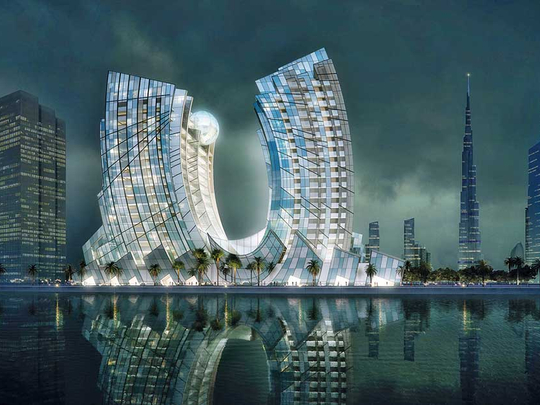
Dubai: It is easy to see Dubai’s latest tower on Business Bay as being U-shaped... but for the developer the highly distinctive design is much more than that.
“What we wanted to create was something that’s a part of this city and its culture,” said Mohammad Miqdadi, general manager of Durar Al Emarat Properties, which is building the twin-tower Dh650 million J One project on a 150x60 metre plot right on the Canal. “The shape mirrors that of a pearl, which is what shaped this city in older times. The building’s curvature represent the different layers of the shell and right at the top of the building, we have the pearl [which is where the “sky restaurant” is located]. And being so close to the water, we have all the elements for a ‘pearl’.”
Whatever be the definition of the shape, the Durar Group’s latest venture certainly pushes the boundaries when it comes to architectural design aesthetics. In Dubai, most developers have tended to play safe in shaping their projects, which also helps them keep a better grip on costs.
But for Durar, the J One was about making a statement. “The name itself — J One — is Arabic for pearl,” said Miqdadi.
Located within the Business Bay enclave, the J One, the developer says, will also benefit from the 150 metre stretch fronting the water. Here too, Durar is interpreting the structure in its own way.
One-half of the tower will feature smaller units and be more in tune with the needs of investors. The other will have slightly bigger apartment formats and which, the developer hopes, will be what end users have in mind.
QHC are the architects. “Because of the design and other elements, we have not gone above the market average for that location,” said Miqdadi. “Prices range from Dh800,000 to Dh4 million and plus for the four-bedroom units. On a per square foot basis, this would be Dh1,600-Dh1,900.”
As of now, work on the three basement levels is underway, with Abu Dhabi-based Ali & Sons as the main contractor. The target is to finish the entire project in the third quarter of 2019.
Durar has built up a portfolio of completed high-profile developments, which includes the Latifa Tower on Shaikh Zayed Road, the mixed-use Sidra Tower with the Fraser Suites, and the Durar 1 in Dubai, leased out to Emirates Group.
“For the immediate future, our project profile will be confined to Dubai and the new one in particular,” said Miqdadi. “We expect to generate Dh850 million in net sales value from the J One, which will also have nine retail outlets. Tower A will feature 257 units across 19 storeys, while Tower B consists of 18 storeys and 90 units. The project also has six town houses, each with a private swimming pool and deck, and private entrances.
“It was 18 months ago that the design was formalised. Initially, we wanted to have a ‘hanging’ restaurant at the top, but when the design was finalised decided it was best to incorporate a sky element.”
It is likely that developers will get more creative on the limited number of plots alongside the Water Canal. In a market where investors are going to value uniqueness — and pay a premium for it — it is up to the developers to come up with the goods on the looks side.
Going beyond the up and up
Dubai has been rightfully called the skyscraper city, and not just for having the world’s tallest tower. Developers have focused on reaching for the skies as a competitive advantage and using it to extract maximum sales potential.
But there are certain structures that go way beyond the cutting edge in terms of design. In many ways, the Jumeirah Beach Hotel built in the late 1990s epitomised the city planners’ wish to do something different. The wave structure was far removed from anything that was created to house a hotel until then.
Then came the Emirates Towers, with the renowned architect Hazel Wong putting her design stamp on it. Wong, more recently, was also associated with the Serenia Residences from Palma Holding.
The freehold boom of the mid-2000s did bring forth some stand-out design elements such as the Cayan Tower (also known as the Infinity Tower and which is striking for its twisting shape).












